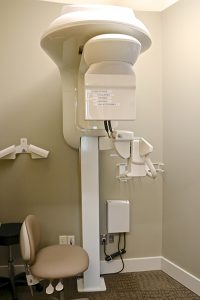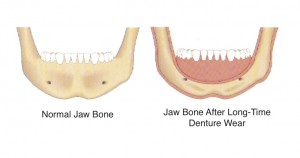Header logo
header top contact widget
Implant Placement
Advanced Skills & Technology Provide The Best Care For Specific Needs
Posted on May 14, 2018 by William J. Claiborne, DDS MS
When our heating system or air condition goes on the blink, I don’t call a do-it-all handyman. I call a trusted HVAC company to schedule a technician who is specially trained in its repair. He (or sometimes she) shows up understanding the specifics of our system and already has the tools (and many parts) at hand to do the job quickly and efficiently – and most of all, correctly!
The same is true when people have periodontal (gum) disease. Seeing a periodontist (a dentist who specializes in accurate diagnosis and treatment of gum disease) provides a number of benefits:
• Proper diagnosis: Do you have periodontal disease? If so, at what stage is your disease? A periodontal specialist has advanced training to properly diagnose all stages of gum disease.
• Proper treatment: I have a reputation for never over-treating or under-treating. While I always want to provide the most successful outcome based on each patient’s specific needs, I never want to put anyone through more time and expense than is necessary. My skills and experience enable me to know what will work best based upon each individual’s unique needs.
• Proper tools and equipment: As a periodontal office, we are fully prepared for the diagnosis and treatment of all stages of gum disease as well as the placement of dental implants (another important realm of the specialty). As such, we can tend to our patients in an efficient and effective manner. This also enables us to provide treatment in minimal time and to an exceptional level of comfort.
• Advanced features: One of the reasons we receive so many referrals from other doctors, dentists, and past/present patients (in addition to trust) is in the environment we provide. Our office is structured to tend to the unique needs of our patients to the highest standards of care possible. For example, in administration of IV sedation (twilight sleep), we utilize an on-site Board Certified Anesthesiologist. Additionally, diagnosis and treatment planning is backed by images from our on-site 3D Cone Beam technology. These features are not required of a periodontal practice. We simply believe that our patients are given better care with them.
• Proper care of patients’ needs: We see our patients far beyond their oral health needs. Here, patients are respected, cared for with compassion and gentle hands, and given the quality of care we would want for ourselves and loved ones. The caregivers who refer to us know this, and the patients who come to us for care experience it firsthand.
In a perfect world, everyone would have excellent periodontal health and teeth that last a lifetime. But, we know we live in a world where gum health can become compromised and teeth can fail. Our goal is to help our patients regain healthy, confident smiles they’ll be proud to share, often and joyfully!
If you feel your gum health is poor or have experienced tooth loss, begin with a consultation appointment. Call 828-274-9440 to schedule. From the very first phone call, I believe you’ll know you are in good hands!
Interesting History Behind Dental Implants
Posted on May 08, 2018 by William J. Claiborne, DDS MS
Would you be surprised to learn that Dental Implants date back to ancient Egypt? Then, get ready for an interesting history lesson!
Archeological digs in Egypt unearthed jaw bones that had seashells or stones carved into tooth shapes positioned to replace lost teeth. The ancient Egyptians weren’t alone in this pursuit.
The Mayan civilization from 600 AD apparently used a similar process to replace missing teeth. A 1930’s excavation in Honduras uncovered a human jaw bone where shell pieces fashioned into tooth shapes were positioned into the sockets of missing teeth.
Attempts to replace teeth in ancient cultures has been discovered over the years across the globe, including North and South America, Middle Asia, and the Mediterranean. Discoveries in a number of ancient cultures have revealed early versions of dental implants, including attempts at implanting teeth made from gold and metal.
In the Middle Ages, early attempts in tooth replacement through implants were made using bone grafting techniques. Minimal success occurred due to infections, often resulting in death. Yet, the pursuit to replace teeth held in the jaw bone continued.
Successful developments were finally experienced by a World War II Army doctor, Dr. Norman Goldberg. After noting that certain metals used in other parts of the body were having consistently successful results, Dr. Goldberg started on a quest to apply this to dental implants.
After the war, Dr. Goldberg teamed with Dr. Aaron Gershkoff. Together, they created an implant type that integrated successfully with bone. Their work was the springboard to developing modern dental implant systems used today. (https://www.aaid.com/about/History.html)
Doctors Goldberg and Gershkoff shared their successes in the dental community through an article published in Dental Digest. This created enthusiasm with other doctors, who worked to fine-tune the implantation process. This also spurred efforts to develop implant designs to accommodate various needs.
When titanium was developed by NASA, Swedish surgeon Per-Ingvar Brånemark, M.D., Ph.D. found that the jaw bone would not only accept implants, it would grow around it to secure them in place. The process of ‘osseo-integration’ was an exciting new development that inspired continued research. (https://www.ada.org/sitecore/content/home-ada/publications/ada-news/2015-archive/january/dr-branemark-father-of-modern-dental-implant-dies-at-85)
Dr. Brånemark’s first titanium dental implant patient (in the mid-1960s) had four titanium implants placed, which lasted until his death four decades later. However, Dr. Brånemark spent years trying to convince the medical and dental communities that titanium would integrate with living bone. It wasn’t until the 1970s that Brånemark implants would be approved in Sweden.
At a professional meeting in Toronto in 1982, Dr. Brånemark presented his system for ‘osseointegrated’ implants. There, he finally received widespread recognition for his methods. Referred to as the father of modern dental implants, Dr. Brånemark’s dental implant system is still manufactured and on the market.
Perfection in the techniques and technology surrounding implant dentistry has continued. Patient now have a wide variety of implant systems available for individual needs. Advancements in dental materials also provide implants patients with replacement teeth that have the look and feel of natural teeth.
An estimated 450,000 dental implants are placed each year with a success rate of over 96% — higher than any other implant-in-bone procedure (including hips and knees). Patients who select dental implants for replacing teeth enjoy an exceptionally natural-looking smile as well as the function like that of ‘real’ teeth.
Dental Implants do more than merely replace missing teeth. They restore the ability to eat the foods you love without worry, laugh confidently and have a smile will last a lifetime. To discuss dental implants, call 828-274-9440 to schedule a consultation.
Are You ‘Sick’ Of Your Denture?
Posted on Apr 10, 2018 by William J. Claiborne, DDS MS
We often hear people, at times of frustration, exclaim “I’m sick to death of…” or “I’m sick and tired of…”
I think we all have make this claim at one time or another. However, when it comes to wearing dentures or partials, being “sick” of them can go in several different directions. They can, indeed, make you “sick and tired” as well as just plain “sick.”
In 2012, NBC News reported on a study that was published in the Journal of The American Dental Association. The study was conducted to determine methods to effectively kill the bacteria crawling all over the material that make up the gum base of dentures and partials.
What was shocking to many was just how serious the bacteria levels were. Dentures, because of their porous nature, can be coated with a sticky bacteria known as biofilm. It has been found that this biofilm can harbor MRSA or bacteria that is resistant to antibiotics. (https://www.nbcnews.com/healthmain/dirty-dentures-dangerous-mrsa-may-be-lurking-dentists-say-662637)
It was also found that the bacteria in the biofilm doesn’t just stay in the mouth. It can be breathed into the lungs where infections become much more difficult to treat.
Especially concerning is the high number of denture and partial wearers who sleep in their appliances. One study found that wearing dentures while sleeping doubles the risk of pneumonia in elderly adults. (https://www.ncbi.nlm.nih.gov/pmc/articles/PMC4541085/)
Remember, bacteria are living, eating organisms. Like any living thing, what eats produces waste. When it comes to oral bacteria, this means that these creatures are defecating in your mouth. That, in itself, is a pretty alarming reality of wearing dentures.
The tiny hide-outs of denture ‘pores’ give oral bacteria an ideal environment to thrive and reproduce. While sleeping in dentures obviously increases the opportunities for this to occur, these icky organisms can create quite an obstacle to adults who have immune systems that are already compromised.
Yet, being “sick” from dentures doesn’t stop there. For those who have worn dentures for many years, the bone that lies underneath the denture has likely shrunk. This process, known as ‘resportion,’ occurs when tooth roots are no longer present in the bone to provide stimulation.
Most denture wearers can sense that something has changed when their once-snug denture begins to slip when eating. Eventually, these slips can cause uncomfortable rubbing on tender gum tissues. The solution, for many, is to alter the diet to include foods that are soft and dissolve easily in the mouth.
The problem with these foods, typically, is they are lacking in the fiber and nutrition necessary for having good overall health. It is no wonder that denture wearers have more gastrointestinal problems and take more medications than people who have their natural teeth.
The problems of dentures go on and on. Renowned implant dentist, lecturer and founder of the Misch Implant Institute, Carl Misch, gives a straight-forward breakdown of the problems associated with wearing dentures in his book, “Dental Implant Prosthetics”
With all the frustrations and complications of wearing dentures, it’s to no surprise that dental implants have become the preferred choice of today’s adult when it comes to replacing natural teeth.
Dental implants are held by the jaw bone, restoring a sturdy foundation for biting and chewing. They also recreate stimulation to the bone that supports them, thus halting the rate of bone loss that occurs from wearing dentures. And, dental implants are designed to last a lifetime, making them an excellent investment.
As a Periodontist, my specialty includes advanced training in the diagnosis and placement of dental implants. Over the years, I have been impressed with their track record, having one of the highest of all implant-in-bone success rates.
Why worry over the health risks associated with wearing dentures and partials? Dental implants are dependable, safe, lasting, and provide a natural look and feel. Call 828-274-9440 to schedule an appointment to determine if dental implants are right for you.
How Dental Implants Can Prevent A ‘Melting Face.’
Posted on Apr 02, 2018 by William J. Claiborne, DDS MS
The aging process isn’t necessarily kind to our appearance. Hair color and texture changes. Age spots creep up. Hair grows where it didn’t used to or thins out in unwanted spots. The skin wrinkles and sags.
While aging gracefully is something we should strive for, it doesn’t mean we’re necessarily thrilled with these changes. Eating a healthy diet and staying active is certainly a good way to stay in shape and retain a more youthful ‘zest’ for life.
While that can help to keep some of the years at bay, some changes caused by the aging process can be avoided, such as wearing sunscreen to avoid age spots. Others can be avoided or halted, including a ‘melting face.’ What is a melting face?
This describes changes to facial appearance when the bone structures that give our face its shape start to shrink. This is caused by the absence of tooth roots from the jaw bone. The stimulation normally provided to the jaw bone from tooth roots no longer exists when natural teeth are removed. This causes the bone to shrink, or ‘resorb.’

Healthy Jaw Bone Vs Bone Loss From Missing Teeth
As the bone mass declines in height and thins out, changes in facial appearance slowly evolve. For example, as the jaw bone thins, deep wrinkles form around the mouth. Eventually, the corners of the mouth will turn down even in a smile. Jowls form on each side of the face as facial muscles detach from the shrinking bone structure.
As the jaw bone continues to shrink, the chin becomes more pointed and the nose seems to get closer to it. This leads to a collapsed mouth that is known as a ‘granny look.’ This look ages the appearance of an individual far beyond their actual years.
Among the many benefits of dental implants, they also provide stimulation to the jaw bone. This helps to halt the process of bone loss. For those who have already lost a great deal of bone loss, bone rebuilding procedures can be performed to restore a healthy, more youthful face shape.
As a periodontist, my dental specialty includes the diagnosis and placement of dental implants. Dental implants are the closest thing to natural teeth, in many ways.
Dental implants restore the ability to bite and chew comfortably and without worry. Because implants are placed in the jaw bone, this provides the same dependable foundation as you once enjoyed with natural teeth.
Unlike a denture, partial or crown-&-bridge combination, dental implants recreate the stimulation to the jaw bone it needs in order to maintain a healthy mass. People are often surprised to learn that the pressure from wearing a denture or partial actually contributes to the rate of bone loss. For those who sleep in their denture, the accelerates the pace even further.
Some things about the aging process are pretty hard to prevent. Others are totally preventable. With the help of dental implants, the shape of your face and the strength of your jaw bone can be preserved even after tooth loss.
Call 828-274-9440 to schedule a consultation to discuss the dental implant system that is best for your needs as well as the process.
Recent Posts
Categories
Archives
- September 2024
- August 2024
- July 2024
- June 2024
- May 2024
- April 2024
- March 2024
- February 2024
- January 2024
- December 2023
- November 2023
- October 2023
- September 2023
- August 2023
- July 2023
- June 2023
- May 2023
- April 2023
- March 2023
- February 2023
- January 2023
- December 2022
- November 2022
- October 2022
- September 2022
- August 2022
- July 2022
- June 2022
- May 2022
- April 2022
- March 2022
- February 2022
- January 2022
- December 2021
- November 2021
- October 2021
- September 2021
- August 2021
- July 2021
- June 2021
- May 2021
- April 2021
- March 2021
- February 2021
- January 2021
- December 2020
- November 2020
- October 2020
- September 2020
- August 2020
- July 2020
- June 2020
- May 2020
- April 2020
- March 2020
- February 2020
- January 2020
- December 2019
- November 2019
- October 2019
- September 2019
- August 2019
- July 2019
- June 2019
- May 2019
- April 2019
- March 2019
- February 2019
- January 2019
- December 2018
- November 2018
- October 2018
- September 2018
- August 2018
- July 2018
- June 2018
- May 2018
- April 2018
- March 2018
- February 2018
- January 2018
- December 2017
- November 2017
- October 2017
- September 2017
- August 2017
- July 2017
- June 2017
- May 2017
- April 2017
- March 2017
- February 2017
- January 2017
- December 2016
- November 2016
- October 2016
- September 2016
- August 2016
- July 2016
- June 2016
- May 2016
- April 2016
- March 2016
- February 2016
- January 2016
- December 2015
- November 2015
- October 2015
- September 2015
- August 2015
- July 2015
- June 2015
- May 2015
- April 2015
- March 2015
- February 2015
- January 2015
- December 2014
- November 2014
- October 2014
- September 2014
- August 2014
- July 2014
- June 2014
- May 2014
- April 2014
- March 2014
- February 2014
- January 2014
- December 2013
- November 2013
- October 2013
- September 2013
- August 2013
- July 2013
- June 2013
- May 2013
- April 2013
- March 2013
- February 2013
- January 2013
- December 2012
- November 2012
- October 2012
- September 2012
- August 2012
- July 2012
- June 2012


